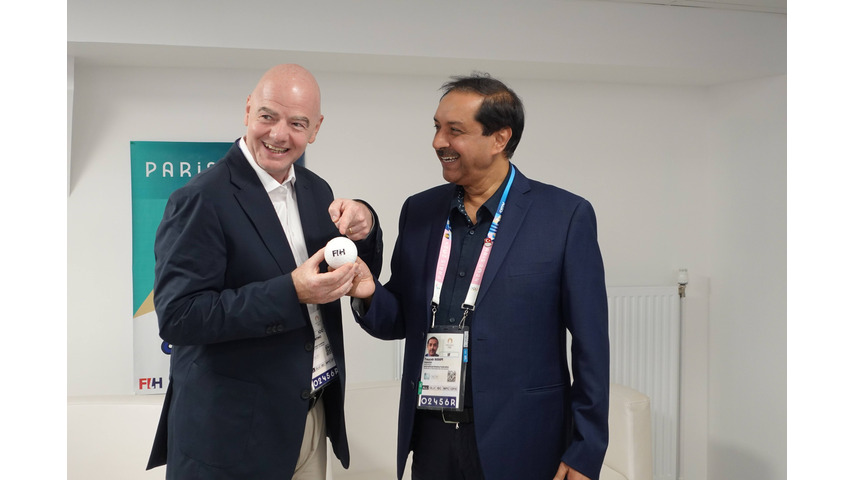- Wed, March 16, 2022

Loading

Loading

FIH and FIFA Innovation Unite to Launch New Dual-Sport Synthetic Turf Guidelines for Hockey and Football
In a landmark collaboration for global sport development, the International Hockey Federation (FIH) and the FIFA Innovation Programme have announced the release of a pioneering guide on dual-sport synthetic turf pitches. Published on April 8, 2025, this new guideline available in English, French, and Spanish aims to revolutionise how synthetic turf fields are developed and utilised for both hockey and grassroots football, particularly at the community and educational levels.
The joint effort, aptly titled Dualsport Pitches for Football and Hockey - Performance and Construction Guidelines, marks a significant leap forward in promoting accessibility, cost-efficiency, and environmental sustainability for sports infrastructure worldwide. With this, FIH and FIFA are addressing the growing demand for multi-sport playing surfaces that cater to diverse community needs while meeting rigorous sport-specific performance standards.
Addressing Modern Sporting Realities with Dual-Sport Surfaces
Across the globe, access to quality sports infrastructure remains a challenge especially for schools, universities, municipalities, and low-income communities. As urban spaces become increasingly multi-functional and land-use restrictions tighten, there’s a growing need for synthetic turf fields that support more than one sport. Recognising this, the FIH and FIFA Innovation team launched a collaborative research and standards development initiative to explore whether the latest innovations in synthetic turf could support the needs of both football and hockey.
Historically, synthetic turf development for elite competitions has been sport-specific, with hockey demanding smoother, low-pile, water-based systems, and football requiring longer pile with energy-absorbing infill. However, advancements in turf technology particularly those geared towards sustainability are now offering hybrid solutions that strike a balance. The result is a set of revised performance parameters that allow dual functionality without compromising player safety, surface durability, or the integrity of either sport.
Combining Performance Standards: A Balanced Benchmark
The new dual-sport pitch guideline combines key elements from the FIFA Basic category and the FIH Multi-Sport category, offering clarity on what is expected from synthetic turf fields intended for dual use. While the FIFA Basic standard outlines durability and safety benchmarks for non-elite, community-level football, the FIH Multi-Sport category provides flexibility for hosting recreational and school-level hockey. The integration of these two frameworks ensures that surfaces meet the practical needs of both sports at the grassroots level.
The guide goes beyond surface specifications. It offers detailed instructions on field layouts, markings, construction layers, and even drainage crucial components for maintaining performance under diverse weather conditions. It also includes a field certification process to ensure that turf systems meet dual-sport performance metrics and are suitable for intended use cases.
This isn't about watering down standards to suit two sports it’s about smart, inclusive design that considers both performance and access. The guide also sets a clear precedent for future innovation, providing a template for the integration of additional sports like lacrosse or rugby into shared turf systems.
A Leap Forward for Community Sports Infrastructure
According to FIH President Tayyab Ikram, this initiative is more than a technical alignment it’s a step toward greater sporting inclusivity. “It truly is fantastic that both the FIFA Innovation team and FIH were able to collaborate for the mutual benefit of grassroots football and hockey,” Ikram stated. “This guide will provide a great help to millions of young football or hockey players around the globe.”
His sentiments reflect a broader vision of how infrastructure can support equitable sport development. As Ikram noted, synthetic turf pitches play a substantial part in the growth of both sports, particularly in urban environments or regions with limited resources. Their resilience in varying climates and capacity to handle frequent use makes them indispensable tools for sports administrators worldwide.
From a sustainability standpoint, the move is equally meaningful. Many of the turf systems under review are aligned with eco-conscious manufacturing standards, including water-saving features, recycled infill options, and low-maintenance installation methods. This aligns with both FIFA and FIH’s broader environmental pledges, offering a model of green innovation in sports infrastructure.
Global Impact: From Policy to Playgrounds
For stakeholders ranging from local councils and school boards to NGOs and national sports associations this guideline is not just technical documentation. It’s a blueprint for maximising limited resources without compromising sport quality. With land often at a premium, especially in developing nations, dual-sport fields mean one investment can serve multiple disciplines, drive participation, and strengthen community engagement.
The guide is now freely available on the FIH Resources Hub and the FIFA Standards portal, and it’s expected that this release will soon influence public procurement tenders, grant application processes, and sports infrastructure planning across multiple regions.
The timing also coincides with increasing efforts by both governing bodies to elevate the role of sport in sustainable urban development. As part of their broader innovation strategies, FIH and FIFA have been exploring partnerships with cities and international bodies to align sport infrastructure projects with the United Nations’ Sustainable Development Goals (SDGs) particularly those focused on health, education, and climate action.
The Future of Turf: Smart, Shared and Sustainable
Ultimately, this initiative underscores a larger movement in global sport multi-use, technologically advanced, and environmentally responsible facilities are the future. The dual-sport synthetic turf model supports increased participation, reduces infrastructure duplication, and reflects a more efficient use of public funds.
It also opens doors for increased collaboration between sports federations, manufacturers, and local governments. As innovations continue in turf technology, there may soon be an emergence of multi-layered systems capable of adapting between surfaces with minimal disruption further expanding possibilities for shared use across different sporting codes.
For now, though, grassroots football and hockey communities have received a tangible tool that will enable better access, better play, and better futures. With FIH and FIFA leading the charge, this is a promising step toward inclusive sporting environments that reflect the values of modern sport: innovation, equity, and sustainability.
Comments:
Leave a Reply